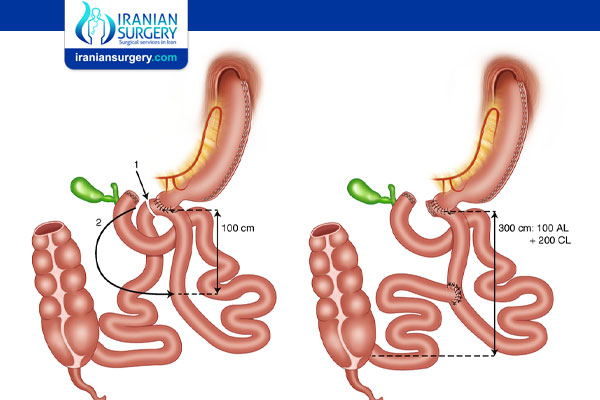Modified Duodenal Switch
Modified Duodenal Switch
What Is Modified Duodenal Switch Surgery?
Over the last few years, a less invasive version of the traditional duodenal switch (DS) has become an option for many patients. This is known as the Modified Duodenal Switch (ModDS). It is also sometimes referred to as SADS, SIPS, SADI, SADI-S, or Loop DS procedure. Instead of two connections as in the roux-en-y gastric bypass, or the more traditional duodenal switch, a single connection is made in a so-called loop configuration. By having one connection instead of two, the surgery is performed more quickly and with less risk of leaks, thereby decreasing the risk of surgery.
Furthermore, in the ModDS procedure, we only bypass about 50% of the small intestine, whereas, in the traditional DS, 85-90% of the small intestine is bypassed. This helps to avoid the main risks of the traditional DS procedure, which are debilitating malnutrition and diarrhea. Both of these are very uncommon in the ModDS procedure. Although the traditional DS led to massive weight loss, a significant number of patients suffered persistent vitamin or protein malnutrition despite taking all the proper supplementation.
Some of the main advantages of the ModDS procedure over the Gastric Bypass (RYGB) are:
. Patients can take aspirin, NSAIDs (ibuprofen, Advil, etc), and steroids, if necessary, without the risk of getting a marginal ulcer, like the RYGB.
. Most effective surgery against diabetes
. Produces the most weight loss
. Decreased risk of bowel obstructions compared to traditional DS and RYGB
Like the gastric bypass (RYGB), the ModDS is both a malabsorptive and restrictive surgery. Restrictive means that the stomach is reduced in size, which restricts the amount of food that you can eat. Malabsorptive surgeries reduce the number of nutrients that your body absorbs by bypassing a portion of the small intestine. The combination of malabsorption and restriction makes the ModDS surgery, like the RYGB, extremely effective at enabling our patients to lose weight and keep it off. Patients can lose more weight with bariatric surgeries that have both restrictive and malabsorptive components.
This surgery involves removing about 80% of your stomach by forming a sleeve gastrectomy. This is the restrictive component and reduces the amount of food that you can consume at one time. Next, the first portion of the intestine located just after the new sleeve, the Duodenum, is divided and a loop of the small intestine is brought up and attached to the Duodenum to bypass about half of the small intestines. This bypass reduces the number of calories that can be absorbed (as well as the amount of fat) by limiting how long food can mix with bile fluid and other digestive juices.
Who Is a Good Candidate for The ModDS?
You may be a good candidate for ModDS if you:
. Have a significant amount of weight to lose (BMI over 50)
. Want your best chance of curing type II diabetes (up to 98%)
. Know that you will be extremely dedicated to a life of vitamins and supplements
. Have conditions that will or may require you to use NSAIDS or Steroids (which patients cannot take if they have a Gastric Bypass)
. Have a strong history of smoking or nicotine
If you are considering this operation as a way to cure Type II Diabetes or maximize your weight loss opportunity long-term, you must be very committed to taking a certain set of vitamins and protein every day for the rest of your life. This is crucial to help you take in adequate vitamins and proteins. With this commitment, the ModDS operation has been shown to be safe and very effective. With a healthy diet and vitamin supplementation, you can start making the most of everything life has to offer.
What Are the Results?
Studies have shown patients at two years after the ModDS patients can lose greater than 95% of their excess weight and more than 90% achieved complete remission of diabetes. However, the longest-term data is just four years old, so while longer-term weight loss results are unknown, they are expected to be similar to the more traditional DS without some of the long-term complications.
Hospital Stay with the ModDS
The surgery takes approximately 60-90 minutes, depending on your past surgical history, scar tissue, and anatomy. This procedure is almost always done laparoscopically through six small incisions in the abdomen. Laparoscopic surgery usually results in a shorter hospital stay, faster recovery, smaller scars, and less pain than open surgical procedures. The typical hospital stay is only one night.
About Iranian Surgery
Iranian surgery is an online medical tourism platform where you can find the best weight loss specialists and surgeons in Iran. The price of Modified Duodenal Switch Surgery in Iran can vary according to each individual’s case and will be determined by an in-person assessment with the doctor.
For more information about the cost of Modified Duodenal Switch Surgery in Iran and to schedule an appointment in advance, you can contact Iranian Surgery consultants via WhatsApp number 0098 901 929 0946. This service is completely free.
Source:


